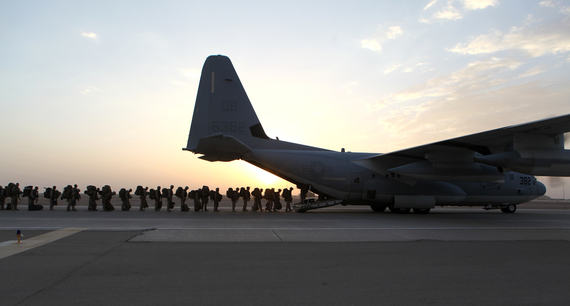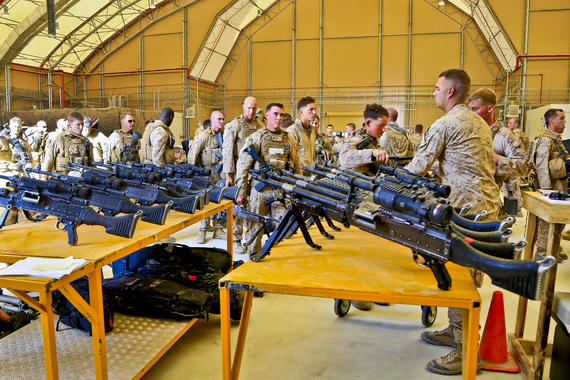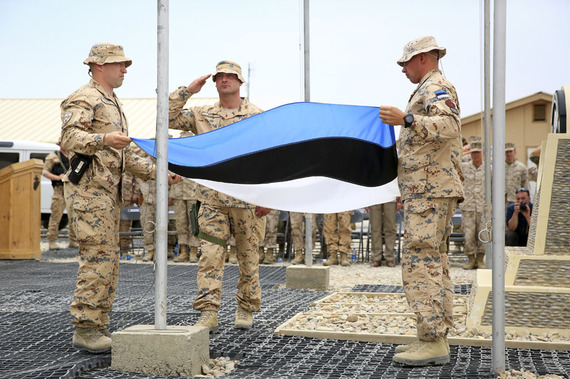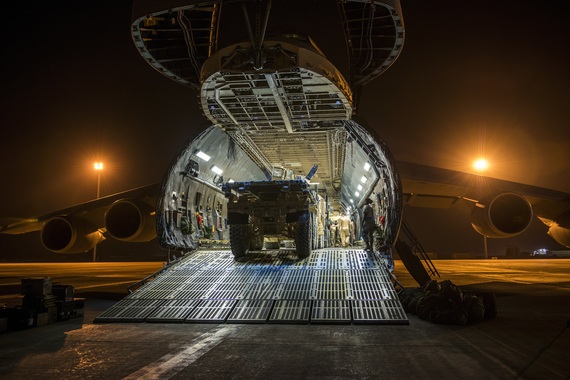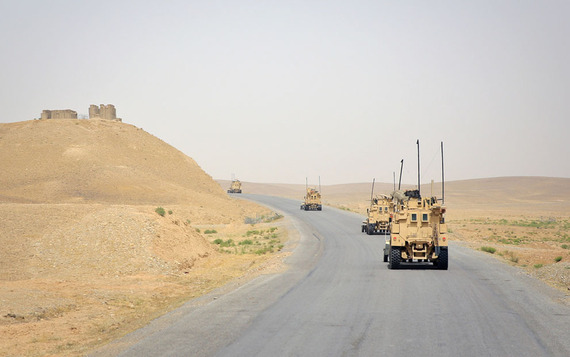Our nation's longest war -- some call it the "good war," others say it is "Obama's war," the military named it "Operation Enduring Freedom" -- is finally coming to an end, or, as the Pentagon formally reports to Congress, we are "ending the U.S. mission in Afghanistan... and transitioning to a train, advise, and assist mission."
While about 9,800 U.S. troops will remain in Afghanistan to support such a non-combat "train, advise, and assist mission," approximately 24,000 troops will be going home under President Obama's "drawdown plan" before the end of the year.
In preparation for the "transition," U.S. and coalition forces have been lowering and folding their flags during ceremonies at various posts and bases and handing over control, missions and military installations to Afghan National Security Forces (ANSF).
A week ago, the United Kingdom handed over control of Camp Bastion to the Afghan forces in Helmand province and neighboring Camp Leatherneck was also formally transferred to the ANSF, effectively ending the United Kingdom's combat mission there and "signaling that the mission for U.S. Marines in the province is also nearing its end," according to the Stars and Stripes.
The joint base of Camp Leatherneck and Camp Bastion is the largest military installation the coalition has transferred to the ANSF in its current wind-down of the combat mission.
The lead photo shows Marines and sailors with Marine Expeditionary Brigade - Afghanistan loading onto a KC-130 aircraft on the Camp Bastion flight line, Oct. 27, 2014. (Photo DOD)
The aircraft departure and the ceremonies represent the first transfer of control of an International Security Assistance Force (ISAF) command to the Afghan National Security Forces, and is a major milestone in the transition of security responsibilities from ISAF to the ANSF.
Below, U.S Marines turn in their M240B machine guns on Kandahar Airfield in Afghanistan following the end of Regional Command Southwest operations in Helmand province, Oct. 27, 2014. (Photo DOD)
Strangely, there were no elaborate press conferences or statements by the White House or by the Department of Defense, nor the fanfare and the celebration that one would expect such an important milestone to deserve. After all, Helmand province has seen some of the bloodiest fighting and high casualties in the U.S.-led war in Afghanistan. After all, the handover of these two mammoth bases is the most concrete signal to date that America's longest war, a war that has taken the lives of nearly 2,400 Americans and has cost almost $800 billion, is finally drawing to a close.
In a recent piece, Colum Lynch at Foreign Policy, offers some possible reasons for the Administration's remarkable silence on the Afghanistan drawdown, including "[t]he degree to which the Obama administration has sought to move beyond a deeply unpopular conflict that marked the opening front in the U.S.-led war on terrorism..." and criticism about the withdrawal timeline and concern over the security consequences of a premature withdrawal from Afghanistan.
Unfortunately, but I am sure well-intentioned, Lynch titles his otherwise excellent column, "Don't Look Now, but the Marines and Brits Just High-Tailed It out of Taliban Stronghold."
Whatever the reasons the Obama administration has for downplaying our nation's exit out of Afghanistan -- whether Ebola, elections or exasperation -- our Marines, soldiers, sailors, airmen and Coasties are neither "high-tailing it" nor slinking out of Afghanistan.
They are leaving with their heads held high, their honor intact, after having served, in the words of the President, "with honor in dusty villages and city streets, and in rugged bases and remote outposts, in Helmand and Kandahar, and Khost and Kunar and Paktika and Nuristan," and because "through this long war [they] never wavered in [their] belief that people deserve to live free from fear -- over here and back home."
During his surprise visit to Bagram Air Base in Afghanistan nearly six months ago, President Obama also alluded to the process of transition to full Afghan responsibility, a process known as "Inteqal" in Dari and Pashtu, and a process that was launched in 2011 and has been well underway with most recently six other nations ending their operations in Helmand province: Bosnia, Estonia, Denmark, Georgia, Jordan and Tonga.
Estonian soldiers, part of the Estonian contingent to Afghanistan, fold their nation's flag for the last time in a ceremonial flag lowering aboard Camp Leatherneck, Helmand province, Afghanistan, on May 9, 2014. The lowering of the Estonian flag formally concluded the county's participation in Operation Enduring Freedom. (Photo: USMC/Lance Cpl. Darien J. Bjorndal via The Atlantic)
Inteqal not only includes turning over responsibilities to the ANSF, but also the bases, posts, installations, equipment and the dismantling, disposing or destroying of what will not be given to the ANSF and cannot or will not be shipped back to the United States.
The Department of Defense describes the logistics part of this massive drawdown in Afghanistan as "... a mammoth undertaking, involving troop redeployments and equipment retrogrades that had peaked at the height of coalition operations in 2007 and 2008. At that time, the United States had 165,000 service members and 505 bases in Iraq - all packed to the gills with everything from weapons systems and computers networks to bunking and dining facilities."
Add to that description "frequently under enemy fire," and one gets a pretty good idea of this logistics nightmare which the military calls a "retrogade," and defines simply as "defensive tasks that involve organized movement away from the enemy."
Foreign Policy looks at it this way: "...in raw tonnage, it's the biggest single military logistical undertaking ever. For size and complexity, think of something in between D-Day and the moon landing."
The following are images of our troops not slinking or high tailing it out of Afghanistan, but doing the jobs they were trained for.
Airmen from the 9th Airlift Squadron and 455th Expeditionary Aerial Port Squadron with Marines from the Marine Expeditionary Brigade load vehicles into a C-5M Super Galaxy Oct. 6, 2014, at Camp Bastion, Afghanistan. Airmen and Marines loaded more than 266,000 pounds of cargo onto the C-5M as part of retrograde operations in Afghanistan. During this mission, the crew reached more than 11 million pounds of cargo transported in a 50-day period. (U.S. Air Force photo/Staff Sgt. Jeremy Bowcock)
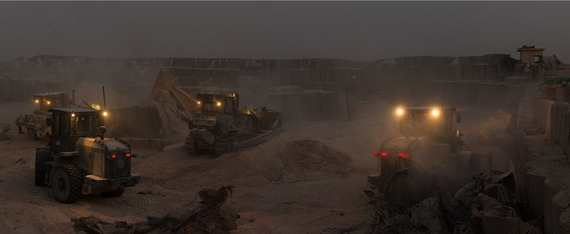
Patrol Base Boldak being "retrogaded" in mid-August of 2014. (Photo: USMC/Cpl. John A. Martinez Jr. via The Atlantic)

U.S. Marines with Marine Heavy Helicopter Squadron 462 (HMH-462) load a CH-53E Super Stallion helicopter into a C-17 Globemaster at Camp Bastion, Helmand province, on November 1, 2013. HMH-462 retrograded the aircraft as part of ongoing demilitarization efforts. (Photo: USMC/Sgt. Gabriela Garcia via The Atlantic)
A convoy of U.S. Marine Corps MRAP vehicles utilized by 1st Battalion, 7th Marine Regiment (1/7), carrying the last 1/7 Marines from Suicide Charley Company and material retrograding from Forward Operation Base (FOB) Sabit Qadam and FOB Nolay travel down Route 1, near Gereshk, Helmand province, on May 4, 2014. Operation Lee removed the last remaining ISAF presence in Sangin and turned control of FOBs Sabit Qadam and Nolay over to the Afghan National Army (ANA). (photo USMC/Lance Cpl. Lance Cpl. Cody Kelley via The Atlantic)
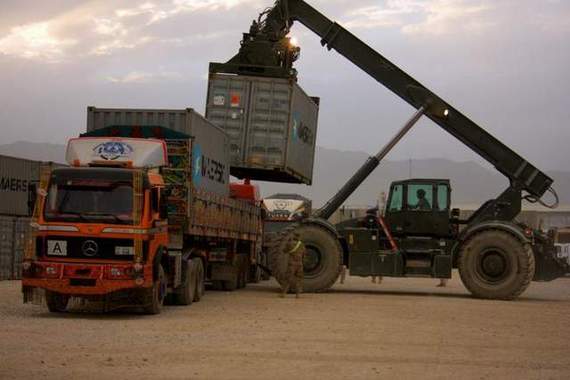
Soldiers load 20-foot shipping containers onto an outbound convoy using a Rough Terrain Container Handler. (Photo by 2nd Lt. Henry Chan / Army, via Army Times)

